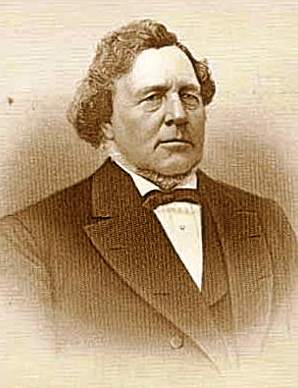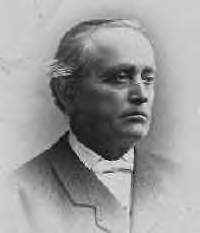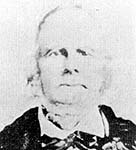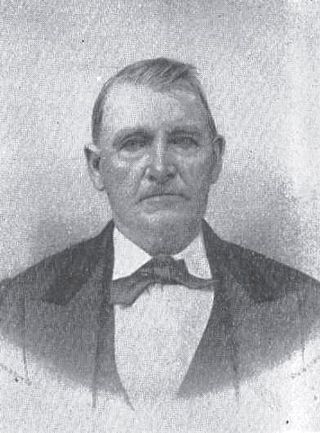
George Albert Smith was an early leader in the Latter Day Saint movement. He served in the Quorum of the Twelve Apostles and as a member of the First Presidency of the Church of Jesus Christ of Latter-day Saints.

Abraham Owen Woodruff was an American missionary who was a member of the Quorum of the Twelve Apostles of the Church of Jesus Christ of Latter-day Saints. He was also the son of LDS Church president Wilford Woodruff.

Luke Johnson was a leader in the Latter Day Saint movement and an original member of the Quorum of the Twelve Apostles from 1835 to 1838. He served in the Quorum with his younger brother, Lyman E. Johnson, and Orson Hyde, his brother-in-law.

The 1890 Manifesto is a statement which officially advised against any future plural marriage in the Church of Jesus Christ of Latter-day Saints. Issued by Church President Wilford Woodruff in September 1890, the Manifesto was a response to mounting anti-polygamy pressure from the United States Congress, which by 1890 had disincorporated the church, escheated its assets to the U.S. federal government, and imprisoned many prominent polygamist Mormons. Upon its issuance, the LDS Church in conference accepted Woodruff's Manifesto as "authoritative and binding."

Erastus Snow was a member of the Quorum of the Twelve Apostles of the Church of Jesus Christ of Latter-day Saints from 1849 until his death. Snow was also a leading figure in Mormon colonization of Arizona, Colorado, and New Mexico.

Brigham Young Jr. served as president of the Quorum of the Twelve Apostles of the Church of Jesus Christ of Latter-day Saints from 1899 until his death. His tenure was interrupted for one week in 1901 when Joseph F. Smith was the president of the Quorum.

Moses Thatcher was an apostle and a member of the Quorum of the Twelve Apostles in the Church of Jesus Christ of Latter-day Saints. He was one of only a few members of the Quorum of the Twelve to be dropped from the Quorum but to remain in good standing in the church and retain the priesthood office of apostle.

The Church Educational System (CES) of the Church of Jesus Christ of Latter-day Saints consists of several institutions that provide religious and secular education for both Latter-day Saint and non–Latter-day Saint elementary, secondary, and post-secondary students and adult learners. Approximately 700,000 individuals were enrolled in CES programs in 143 countries in 2011. CES courses of study are separate and distinct from religious instruction provided through wards. Clark G. Gilbert, a general authority seventy, has been the CES commissioner since August 1, 2021.

Daniel Spencer was the last mayor of Nauvoo, Illinois prior to the revocation of its first charter.

Zera Pulsipher was a First Seven Presidents of the Seventy of the Church of Jesus Christ of Latter-day Saints. In that capacity, he provided leadership to the early Mormon community, most notably in the exodus of a large group of Saints from Kirtland, Ohio. He was also an active missionary who baptized Wilford Woodruff into the LDS Church.

Leonard Wilford Hardy was an early convert in the Latter Day Saint movement, a Mormon pioneer and a member of the presiding bishopric of the Church of Jesus Christ of Latter-day Saints from 1856 until his death.
Janne Mattson Sjödahl was a Swedish convert to the Church of Jesus Christ of Latter-day Saints and was the author of influential commentaries on LDS Church scriptures. Sjödahl was among the first commentators to advance a "limited geography model" for the theorized geography of the Book of Mormon.

John Daniel Thompson McAllister was a 19th-century regional leader of the Church of Jesus Christ of Latter-day Saints.

Lorin Farr was a Mormon pioneer and the first mayor of Ogden, Utah.

The Church of Jesus Christ of Latter-day Saints has had a presence in Mexico since 1874. Mexico has the largest body of LDS Church members outside of the United States. Membership grew nearly 30% between 2011 and 2021. In the 2010 Mexican census, 314,932 individuals self-identified most closely to the LDS Church.

The Church of Jesus Christ of Latter-day Saints is the second-largest religious denomination in Arizona, behind the Roman Catholic Church. In 2022, the church reported 439,411 members in Arizona, about 6% of the state's population. According to the 2014 Pew Forum on Religion & Public Life survey, roughly 5% of Arizonans self-identify most closely with the Church of Jesus Christ of Latter-day Saints.

Woodruff is an unincorporated community in Navajo County, Arizona, United States. Woodruff is 10.5 miles (16.9 km) southeast of Holbrook. Woodruff has a post office with ZIP code 85942.

Margarito Bautista was a Mexican evangelist and religious founder who wrote and preached for the Church of Jesus Christ of Latter-day Saints. After converting in 1901, Bautista preached for the church through word and writing for three decades and spent time in Mexico and Utah. During this time, Bautista developed a theology that fused Book of Mormon doctrine with Mexican nationalism, and he claimed Mexicans held a birthright to lead the church and someday the world. The church's Anglo-American leaders often considered Bautista's interpretations out of line with official doctrine, but they became very popular with Mexican Latter-day Saints.

















